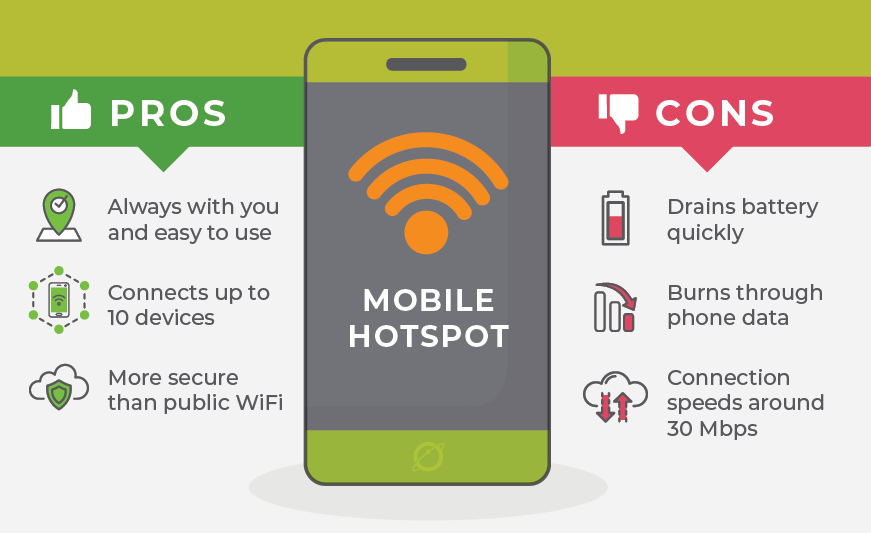What is a Mobile Hotspot?
Summary: A mobile hotspot is a feature that virtually every smartphone has, but not everyone understands or knows when to use it. By creating a WiFi network for your devices, a mobile hotspot can be a more secure connection option than a cafe or coffee shop for people on the go — but it can also burn through your phone battery or data plan.
Ever wondered what the “personal hotspot” option is in your phone settings? Or how to use it? It’s actually easier — and handier — than you might think. The downside? It can burn through your phone data pretty quickly. But we’re breaking down the ins and outs for you so you can get an internet connection wherever you are.
What is a Hotspot?
A hotspot offers a WiFi connection from your phone to your other devices. If your phone is connected to your mobile data network (and has a few bars), it can turn the signal into a WiFi network for your devices. As a bonus, your phone can still function as a phone and make calls and send texts.
This might sound like a more basic version of a wireless home internet device to you — and you’d be right! Wireless home internet and mobile hotspots function in largely the same way: converting data signals from cell phone towers into a usable WiFi network for other devices.

The biggest difference is their scalability. While a mobile hotspot can generally support up to 10 devices with speeds around 30 Mbps, fixed wireless devices can support up to 64 devices with speeds up to 100 Mbps. But it’s hard to beat the convenience of a hotspot right there on your smartphone.
Using a hotspot can burn through your phone battery fairly quickly, especially depending on how many devices you have connected. For example, you can connect five of your coworkers’ laptops to your hotspot network so you can work together — but that requires a lot more power from your phone, and you’ll see the battery fade sooner.
When Should I Use a Mobile Hotspot?
So yes, a mobile hotspot is convenient — but when should you actually use it? If you’re working remotely, like from a coffee shop or park, it can offer a more secure connection than if you connect to a public, open WiFi network. If your power is down (or your high-speed home internet connection is being worked on), you can also opt for a mobile hotspot. We wouldn’t recommend it if your power is down indefinitely, because you’ll want to save your battery, but it can get you connected to a few things that you need to take care of.
Or, you can use it for more specific instances than remote work or power outages. Maybe you feel comfortable scrolling social media on public, unprotected WiFi. But if you’re looking to check your bank accounts or make a purchase, a secure connection through your hotspot is a better option. Any time you’re accessing confidential information (like ordering online, viewing your health information, banking, and more), make sure you’re on a secure connection.
A WiFi network that is open (not password protected) makes you more vulnerable to hackers and identity theft because the information you’re sending and receiving is easier to hijack. So, if you must check it while on the go, opt for your own private, mobile hotspot instead of public WiFi.
How Do I Enable My Mobile Hotspot?
Does a mobile hotspot sound like something that could add value to your connection? Chances are, your smartphone is already capable of creating one. It’s easy to check! For iPhones, simply go to Settings > Personal Hotspot. On Androids, go to Settings > Network & Internet > Hotspot & Tethering > WiFi Hotspot.
Once you’ve enabled your hotspot, you can choose to share it with other users, change the network password, and configure other system setups. Then, when you’re done, make sure you disconnect your devices and turn the hotspot off.
A hotspot can burn through your data quickly, but it does depend on what you’re using it for. Just like data usage on your home high-speed internet plan, high-data activities like streaming video will require more than checking your email. (Think 250 MB vs. 1 MB over an hour, respectively.) Your mobile carrier should have more information on how much hotspot data you can use over the course of a month before your speeds will be slowed down.
A mobile hotspot is an easy way to create a secure connection for multiple devices, virtually anywhere. While it’s great for on-the-go work and secure access, it can also burn through your phone battery and mobile data plan, so we recommend using it sparingly. Think situations that require security or safety or in emergencies for when you’ll want it. If you’re looking for the ease of a mobile hotspot with a little more support for your devices, check out wireless home internet — it’s the best of both worlds.